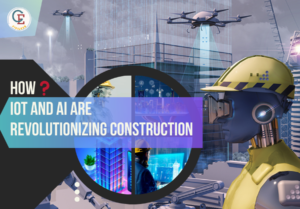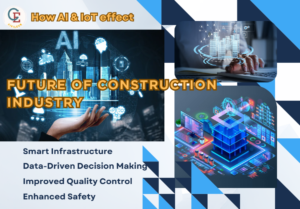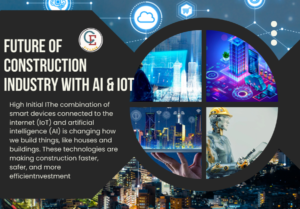The combination of smart devices connected to the internet (IoT) and artificial intelligence (AI) is changing how we build things, like houses and buildings. These technologies are making construction faster, safer, and more efficient. By using devices that can talk to each other and AI that can learn and make decisions, construction companies can do their work better than ever before. This means not only getting things done quicker but also in ways that are better for the environment and for people. IoT devices enable real-time sharing of data and information across different teams and departments, enhancing coordination and decision-making.This seamless flow of information not only improves project efficiency but also fosters a more collaborative and transparent work environment, ultimately leading to better project outcomes. In this blog “How IoT and AI are Revolutionizing Construction ?” we come across to know the uses ofIoT and AI in construction of Smart Buildings, powered by the integration of Internet of Things (IoT) and Artificial Intelligence (AI), are at the forefront of this revolution, promising sustainability, efficiency, and comfort like never before.
How IoT and AI are Revolutionizing Construction ?
IoT: The Backbone of Connectivity
IoT devices serve as the nervous system of Smart Buildings, connecting various components and systems to gather data and enable communication. These devices can range from sensors monitoring temperature, humidity, and occupancy to actuators controlling lighting, heating, ventilation, and air conditioning (HVAC) systems.
Through IoT, buildings become living entities, constantly gathering information about their surroundings and adapting in real-time to optimize performance. For instance, sensors can detect when a room is unoccupied and adjust lighting and HVAC settings accordingly, leading to significant energy savings.
AI: Transforming Data into Insights
But data alone is not enough. This is where Artificial Intelligence steps in, transforming raw data into actionable insights. AI algorithms analyze the vast amounts of data collected by IoT devices to identify patterns, predict future trends, and make informed decisions.
For example, AI can analyze historical energy consumption data to predict future demand patterns, allowing building management systems to optimize energy usage and reduce costs. Moreover, AI-powered predictive maintenance can detect potential equipment failures before they occur, preventing costly downtime and extending the lifespan of building systems.
Sustainable Construction Practices
Smart Buildings are not only about operational efficiency but also about sustainability. By leveraging IoT and AI technologies, construction practices can be optimized to minimize environmental impact and resource usage.
For example, smart computer programs can look at building plans and find ways to save energy, like using better insulation or adding solar panels for power. Also, special sensors can keep an eye on what’s happening at construction sites to make sure we’re being eco-friendly and not wasting materials.
Enhancing Occupant Comfort and Safety
In addition to sustainability and efficiency, Smart Buildings prioritize occupant comfort and safety. IoT sensors can monitor indoor air quality, temperature, and lighting levels to create a healthy and comfortable environment for building occupants.
Moreover, AI-powered security systems can analyze video feeds in real-time to detect and respond to potential threats, enhancing safety and peace of mind. In the event of an emergency, such as a fire or intrusion, these systems can automatically alert authorities and initiate evacuation procedures, potentially saving lives.
How this effect the future of construction industry ?
In the future, construction will change a lot because of two special technologies: IoT and AI. These technologies help make building things easier and better. Machines will do more work as compared to human beings, which means buildings will be built faster and effectively. So, in the future, building things will be quicker, safer, and better for our planet, all thanks to these cool new technologies.
As these technologies continue to use day by day and become more widespread, we can expect to see advanced techniques how construction projects are planned, executed, and managed. The future of the construction industry will be known by increased automation, precision, and efficiency. Tasks that were once time-consuming and labor-intensive will be done fastly through the use of smart devices and AI algorithms, The use of IoT and AI will enable construction companies to adopt more sustainable practices, minimizing waste and environmental impact. Safety measures akso enhanced, with real-time monitoring and predictive analytics helping to prevent accidents and ensure the well-being of workers on-site. Ultimately, the future of the construction industry will be defined by innovation, collaboration, by the use of IoT and AI technologies.
Increased Efficiency: IoT sensors and AI algorithms streamline construction processes, from project planning and design to execution and maintenance. This efficiency translates to faster project delivery times, reduced costs, and improved productivity, and also helping construction companies to take on more projects and compete more effectively in the market.
Sustainability: By optimizing energy usage, reducing waste, and incorporating sustainable practices, IoT and AI-enabled construction projects contribute to environmental conservation and also enables eco-friendly development.
Enhanced Safety: AI-powered safety systems can detect and mitigate potential hazards on construction sites, reducing the risk of accidents and injuries. Real-time monitoring of worker activities and environmental conditions allows for proactive intervention, creating safer work environments
Improved Quality Control: IoT sensors can monitor construction materials and processes in real-time, detecting defects or deviations from specifications early in the construction process. AI algorithms can analyze this data to identify areas for improvement and optimize quality control measures, resulting in higher-quality construction projects and increased client satisfaction.
Smart Infrastructure: The concept of Smart Buildings extends beyond individual structures to encompass entire smart cities and infrastructure networks. IoT sensors embedded in roads, bridges, and utilities can monitor structural integrity, traffic flow, and energy usage in real-time. AI algorithms can analyze this data to enhance infrastructure performance.
Data-Driven Decision Making: The data generated by IoT sensors and AI analytics enables construction companies to make more informed decisions at every stage of the project cycle. From predictive maintenance and supply chain optimization to risk management and stakeholder engagement, data-driven insights drive continuous improvement and innovation in the construction industry.
Overall, the introduction of IoT and AI technologies promises to us in a new era of innovation, efficiency, and sustainability in the construction industry.
What are the challenges currently faced by construction industry to use this technology ?
Using new technology like IoT and AI in construction sounds great, but there are some challenges. One big challenge is that not all construction companies have that much of money to adapt these advanced technology or know-how to use these advanced tools. It can be expensive to buy and set up all the smart devices and computers needed for IoT and AI. Also, some workers might not be these technology properly. Another challenge is that the construction sites themselves can be tough places for technology. Dust, mud, and extreme weather can damage the gadgets. Plus, there are concerns about keeping all the data collected by these devices safe from hackers. So, while IoT and AI have a lot of potential to make construction better, there are still some hurdles to overcome before they can be used everywhere. Despite these challenges, as technology continues to improve and become more accessible, the construction industry will likely find ways to overcome these obstacles and fully embrace the potential of IoT and AI.
High Initial Investment: The Initial costs in set up IoT and AI technologies, including hardware, software, and training, is high and can not affordable by for many construction companies, particularly small and medium-sized enterprises (SMEs). This financial barrier may restrict some firms from investing in these technologies despite their long-term benefits.
Data Privacy and Security Concerns: IoT devices collect all type of sensitive data related to construction projects, including project plans, schedules, and worker information. Ensuring the privacy and security of this data is crucial to prevent unauthorized access, data breaches, and cyberattacks. Construction companies must implement robust cybersecurity measures and adhere to data protection regulations to reduce these risks effectively.
Limited Technical Expertise: The successful implementation and operation of IoT and AI technologies require specialized technical expertise, including data analytics, machine learning, and cybersecurity. But the construction industry traditionally lacks these skills, mainly there are unskilled man power available in construction industry.
Complex Regulatory Landscape: The construction industry operates within a complex regulatory environment, with various regulations and standards governing safety, environmental sustainability, and building codes. Ensuring compliance with these regulations while integrating IoT and AI technologies adds an additional layer of complexity and may require significant time and resources to navigate effectively.
Reliability and Maintenance Challenges: IoT devices and AI algorithms have risk of technical failures, software bugs, and maintenance issues, which can disrupt construction operations and compromise project completion dates. Making sure that these new technologies work well all the time and fixing any problems quickly are really important. This helps to make sure they’re always up and running, so we can get the most out of them.
To solve these problems, everyone involved in the construction industry needs to work together. This includes construction companies, the people who make the technology, government leaders, and schools that teach construction skills. If we all work together, we can figure out how to use IoT and AI better. This will help us build things faster, cheaper, and in a way that’s better for the environment.
For a deeper dive into construction insights and industry updates, we invite you to explore our extensive collection of construction blogs. Gain valuable knowledge and stay updated by navigating through the following blog links. Happy exploring
Crafting Your Dream Bedroom: Simple Steps to a Cozy Retreat
Mumbai Trans Harbour Link : Atal Setu 2024
Feel free to follow us there on Instagram and drop a comment to say hello!



